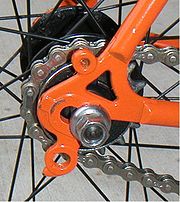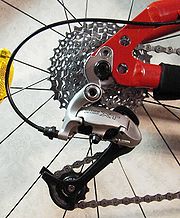
Dropout (bicycle part)
Encyclopedia


Bicycle frame
A bicycle frame is the main component of a bicycle, on to which wheels and other components are fitted. The modern and most common frame design for an upright bicycle is based on the safety bicycle, and consists of two triangles, a main triangle and a paired rear triangle...
or fork
Bicycle fork
A bicycle fork is the portion of a bicycle that holds the front wheel and allows the rider to steer and balance the bicycle. A fork consists of two fork ends which hold the front wheel axle, two blades which join at a fork crown, and a steerer or steering tube to which the handlebars attach ...
where the axle of the wheel
Bicycle wheel
A bicycle wheel is a wheel, most commonly a wire wheel, designed for bicycle. A pair is often called a wheelset, especially in the context of ready built "off the shelf" performance-oriented wheels....
is attached.
On bicycles that do not have a derailleur or other chain tensioning device, rear horizontal dropouts allow adjustment of chain tension, and can accommodate a range of chain lengths or cog sizes. They were standard on most older derailleur bicycles from before the 1990s. An older derailleur-equipped bicycle with horizontal dropouts can be readily converted into singlespeed, fixed gear or to use an internally geared hub.
Track bicycle
Track bicycle
A track bicycle or track bike is a bicycle optimized for racing at a velodrome or outdoor track. Unlike road bicycles, the track bike is a fixed-gear bicycle and so has a single gear and neither freewheel nor brakes. Tires are narrow and inflated to high pressure to reduce rolling resistance...
s traditionally do not utilize dropouts, but instead have track fork ends, on which the opening faces rearwards. Because they do not have dropouts, the chain must be derailed from the cog before the rear wheel can be removed from a typical track bike. Some single-speed bicycle
Single-speed bicycle
A single-speed bicycle is a type of bicycle with a single gear ratio. These bicycles are without derailleur gears, hub gearing or other methods for varying the gear ratio of the bicycle....
s intended for street or trail use are also equipped with track fork ends instead of dropouts.
Rear vertical dropouts have the slot facing downwards. The advantage is that the wheel axle cannot slip forward compared with horizontal dropouts. The disadvantage is that on a bicycle without a rear derailleur but with vertical dropouts, the chain tension cannot be adjusted by moving the wheel forwards or backwards, and needs another means of chain-tensioning, by a derailleur, chain tensioner, or eccentric
Eccentric (mechanism)
In mechanical engineering, an eccentric is a circular disk solidly fixed to a rotating axle with its centre offset from that of the axle ....
bottom bracket
Bottom bracket
The bottom bracket on a bicycle connects the crankset to the bicycle and allows the crankset to rotate freely. It contains a spindle that the crankset attaches to, and the bearings that allow the spindle and cranks to rotate. The chainrings and pedals attach to the cranks...
or rear hub. Fixed wheel bicycles cannot use any form of chain tensioning device, because the lower run of chain is pulled very tight when using the transmission as a brake.
In general, a modern bicycle frame intended for derailleur gears
Derailleur gears
Derailleur gears are a variable-ratio transmission system commonly used on bicycles, consisting of a chain, multiple sprockets of different sizes, and a mechanism to move the chain from one sprocket to another...
will have a vertical dropout, while one designed for singlespeed
Single-speed bicycle
A single-speed bicycle is a type of bicycle with a single gear ratio. These bicycles are without derailleur gears, hub gearing or other methods for varying the gear ratio of the bicycle....
or hub gear
Hub gear
A hub gear, internal-gear hub, or just gear hub is a gear ratio changing system commonly used on bicycles that is implemented with planetary or epicyclic gears. The gears and lubricants are sealed within the hub-shell of the bicycle's rear wheel, as opposed to derailleur gears, where the gears and...
s will have horizontal dropouts or track fork ends.
Derailleur hanger
The derailleur hanger or mech hanger is the part of the dropout that the rear derailleurDerailleur gears
Derailleur gears are a variable-ratio transmission system commonly used on bicycles, consisting of a chain, multiple sprockets of different sizes, and a mechanism to move the chain from one sprocket to another...
attaches to.
Most non-steel framed
Bicycle frame
A bicycle frame is the main component of a bicycle, on to which wheels and other components are fitted. The modern and most common frame design for an upright bicycle is based on the safety bicycle, and consists of two triangles, a main triangle and a paired rear triangle...
bikes have a separate removable derailleur hanger, generally made from aluminium which is bolted to the dropout. These are intended as a cheap replaceable part so that in the event of an accident or mechanical problem that could damage the derailleur or frame
Bicycle frame
A bicycle frame is the main component of a bicycle, on to which wheels and other components are fitted. The modern and most common frame design for an upright bicycle is based on the safety bicycle, and consists of two triangles, a main triangle and a paired rear triangle...
, the derailleur hanger breaks or deforms instead. Sometimes a shear bolt which is designed as a weak point will also be used. There are dozens of different derailleur hangers available and one model is seldom interchangeable with another.
In general, steel-framed bikes do not have a removable derailleur hanger, because a steel
Steel
Steel is an alloy that consists mostly of iron and has a carbon content between 0.2% and 2.1% by weight, depending on the grade. Carbon is the most common alloying material for iron, but various other alloying elements are used, such as manganese, chromium, vanadium, and tungsten...
dropout and hanger is stronger and therefore less likely to be damaged, and also it is more malleable and less likely to work harden during deformation and generally can be bent back into shape without breaking.
It is important for proper indexed shifting for the derailleur hanger to be properly aligned. The rear derailleur bolt hole must be close to parallel with the rear axle. If it is out of alignment, the rear derailleur will not move far enough, with respect to the rear sprockets
Cassette (bicycle part)
On a bicycle, the cogset or cluster is the set of multiple rear sprockets that attaches to the hub on the rear wheel. A cogset works with a rear derailleur as part of the drivetrain to provide multiple gear ratios to the rider. Cogsets come in two varieties, cassettes or freewheels, of which...
, with each click. A special tool
Bicycle tools
Various bicycle tools have evolved over the years into specialized tools for working on a bicycle. Modern bicycle shops will stock a large number of tools for working on different bicycle parts...
exists to measure and correct misaligned hangers.
On frames with no derailleur hanger, a direct mount derailleur or derailleur with a hanger plate is used. These only fit bikes with horizontal dropouts, and are held in place by a small bolt and the rear wheel axle. These have now been effectively superseded by the derailleur hanger. Since a derailleur designed to be fitted to a separate hanger will be aligned lower on the bike than one that bolts directly onto the frame, it follows that a derailleur must be selected firstly with the mounting method in mind.
Lawyer lips
Lawyer lips or lawyer tabs (a type of positive retention device) are tabs fitted to the fork ends on the front forkBicycle fork
A bicycle fork is the portion of a bicycle that holds the front wheel and allows the rider to steer and balance the bicycle. A fork consists of two fork ends which hold the front wheel axle, two blades which join at a fork crown, and a steerer or steering tube to which the handlebars attach ...
of bicycles sold in some countries (particularly the U.S.) to prevent a wheel from leaving the fork if the quick release skewer comes undone. They were introduced in response to lawsuits supported by experts including John Forester, in cases where incorrectly adjusted quick release wheels came out of the forks. Lawyer tabs are designed to compensate for the fact that many riders do not know how to operate a quick release properly: some riders treat them as a folding wing nut, and others do not tighten them enough for fear of snapping them or shearing the skewer (both are not likely given the normal range of human strength, and the mechanical advantages involved, as long as the skewer is not damaged or flawed).
A side-effect is that the quick release, which was developed to allow the wheel to be removed without having to unscrew any components, no longer works as designed: the skewer must be unscrewed in order to remove the wheel (although tools do remain unnecessary). This means that the tension on refitting must be adjusted again. Some cyclists file off the lawyer tabs so the quick release works as originally intended.
A correctly secured quick release is unlikely to be ejected from the dropout in normal use where rim brakes
Bicycle brake systems
A bicycle brake is used to slow down or stop a bicycle. There have been various types of brake used throughout history, and several are still in use today...
are in use, although recently there has been some evidence, notably from James Annan, a British scientist working in Japan, suggesting that the moments
Moment (physics)
In physics, the term moment can refer to many different concepts:*Moment of force is the tendency of a force to twist or rotate an object; see the article torque for details. This is an important, basic concept in engineering and physics. A moment is valued mathematically as the product of the...
in disc brake
Disc brake
The disc brake or disk brake is a device for slowing or stopping the rotation of a wheel while it is in motion.A brake disc is usually made of cast iron, but may in some cases be made of composites such as reinforced carbon–carbon or ceramic matrix composites. This is connected to the wheel and/or...
systems can cause quick-release front wheels to be ejected past the lawyer tabs. A small number of serious crashes have been attributed to this cause. This is controversial, and the fork manufacturers have not admitted a fault, although there is some evidence that they may accept the principle, and advice on checking quick release tension has been strengthened. A complete solution to ejection risk would involve mounting the front disc brake caliper in front of the fork blade rather than behind, as the reaction force on the disc would then be into, rather than out of, the fork-end. However, this would involve major retooling by fork and brake manufacturers, though at least one manufacturer has placed the disc caliper mounts on the front of the right fork blade. This allows standard brakes to be used, and also makes it easier to mount mudguards.
Eyelets
Dropouts may support one or more eyelets, small protruding tabs with holes, often threaded, to facilitate the mounting of racksLuggage carrier
A luggage carrier, also commonly called a rack, is a device attached to a bicycle to which cargo or panniers can be attached. This is popular with utility bicycles and touring bicycles....
and fenders.
Adjustment screws
Some rear, horizontal, forward-facing dropouts have small adjustment screws threaded through the very rear to aid in positioning the axle precisely. The screws may be fitted with springs to keep them from moving.The most common screw size for the adjustment screws is M3.
Chaintugs


